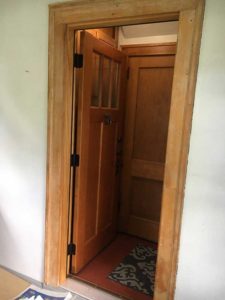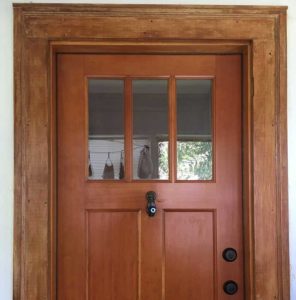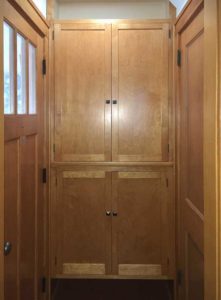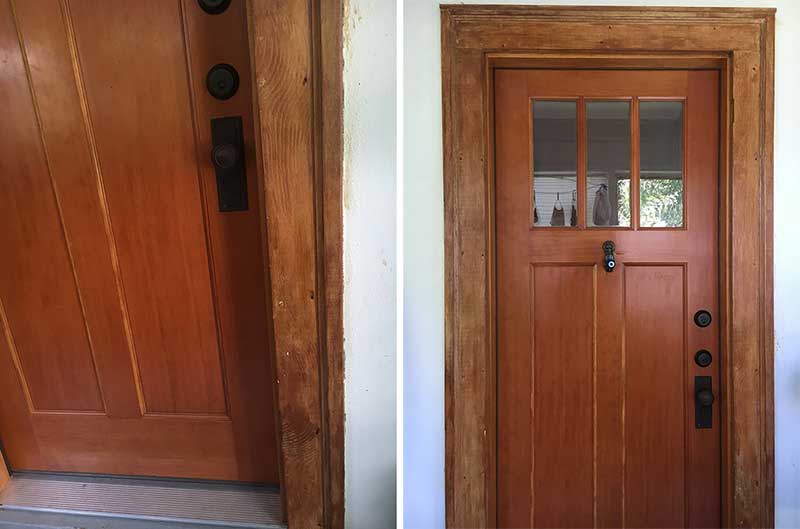Small Home Gazette, Winter 2021
Staining Old Door Trim
Accepting Imperfect, for Now
Wood staining is an art. Do not be misled by online claims like “Wood staining is actually one of the simpler procedures in the wood finishing process” and think it is easy to get right—especially when converting painted wood to stained.
I was experienced. I had previously stained all of the new trim and window sashes installed during our basement and second floor remodels. As part of the kitchen remodel, I had refinished the varnished pantry and three interior door frames to achieve the lighter, warm-toned oak color my husband Pete and I preferred. Though time consuming and messy, these projects were all successes. But, none of these surfaces had been painted.
Preparation, Delays and Failure
 I try hard to honor my well-built home with quality work. Before starting my trim project, I researched the techniques and tools required for prep and finishing. I stripped the trim to bare wood a year earlier, using a heat gun followed by extensive sanding with the recommended progression of paper grits.
I try hard to honor my well-built home with quality work. Before starting my trim project, I researched the techniques and tools required for prep and finishing. I stripped the trim to bare wood a year earlier, using a heat gun followed by extensive sanding with the recommended progression of paper grits.
Even with all the online articles and videos on staining old wood that I consumed—plus my past successes and application of a pre-stain wood conditioner, I still failed. The color is off, and the stain has slight blotches in some places.
My project failed for lots of reasons. I could not adequately test the stain on the wood, such as test staining a sample board with the same characteristics. I also lack experience matching stain colors between different wood types. And I had never converted painted wood to stained. Although I researched extensively, the how-to experts I read did not sufficiently delve into potential problems.
To see if I could easily remedy my mistakes, I did follow-up online research, looking for fixes. The results (see Hindsight Resources section) gave me a lot more tips on how I could have better approached my project. Sigh.
Accepting Imperfect
I cannot give you personally tested tips on how to successfully refinish old wood trim. But I will give you a broader tip: If you are an amateur at home repair, be kind to yourself when a project fails.
I recently attended a webinar on “The Benefits of Failure.” In it, presenters mentioned a study that indicated people who achieved top levels of mastery in their fields spent an average of 10,000 hours honing their skills, which translates to about nine years (five days a week at four hours a day). Other experts add in talent, motivation, and opportunity as success factors. Some refute the 10,000 hours. Fine, divide it by 10, and I am still nowhere near mastery of staining. Web articles say the pros make mistakes, too.
 For now, I will reframe how I think about my door’s trim rather than rework the finish. At 96 years old, the back entry tells a story. The frame’s scratches and gouges say it has seen countless comings and goings. The wood’s grain recalls slow-growing mature trees. The hinge cutouts from a long-gone storm door and the white paint embedded deeply in old pockmarks speak to changing owner preferences.
For now, I will reframe how I think about my door’s trim rather than rework the finish. At 96 years old, the back entry tells a story. The frame’s scratches and gouges say it has seen countless comings and goings. The wood’s grain recalls slow-growing mature trees. The hinge cutouts from a long-gone storm door and the white paint embedded deeply in old pockmarks speak to changing owner preferences.
And now, the stain blotches and mismatched color reveal an owner with a limited budget and a desire to retain old character instead of replacing it with inferior materials. Someday, I will find the energy to tackle this project again. Until then, my home and I will be imperfect together.
Hindsight Resources
After my stain fail, my new research included search terms like: “How to fix blotchy wood stain” and “Can old oil paint be hard to remove from wood?” These searches yielded new tips that might help in future refinishing projects. Wetting a board with paint thinner will sometimes reveal darker areas that are likely to blotch.
- See “How to Control Blotching,” Popular Woodworking.
- Conceal light blotching with an oil-based gel stain glaze. See “Avoid (or fix) Blotchy Stain,” Wood Magazine.
- Use a scraper to shave a test patch through the various paint layers. If the bottom layer is paint (rather than varnish), it is a good sign that the wood is unworthy of stain. See “How to Strip Paint From Wood,” This Old House.













